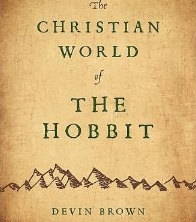Welcome to Tumnus’s Book Shelf where we review any and all books related to Narnia and CS Lewis! For this weeks review, we will be looking at Devin Brown’s Inside Prince Caspian
Book Title: Inside Prince Caspian
Author: Devin Brown
Publisher: Baker Books (January 1, 2008)
ISBN-10:0801068029
ISBN-13:978-0801068027
Summary of the book:
The Inside Narnia series continues with Inside Prince Caspian. In a careful, chapter by chapter analysis of the second book in the Narnian Chronicles, Devin Brown looks at the literary, mythical, moral and spiritual aspects of the Pevensie’s return to Narnia. From growth of the characters, to the ways the land of Narnia had changed since the four children were last in Narnia, to the absence of the magic in the land, readers learn how they themselves may grow in an ever changing world and bring back some of the real “magic” of the secondary world of Narnia into their world as well.
Review:
With 2008 being the year for the theatrical release of Prince Caspian, it is safe to say we will see a slew of Narnia related books hitting the shelves between now and the end of the year. Some will be reprints, others will be new. Devin Brown’s Inside Prince Caspian is the first of the new Narnia related books to come out, and continues the commentary series that was started during the release of the first film.
Following the formula set before him in Inside Narnia, Devin Brown reminds readers again what his focus is with the Inside Narnia series. He is looking at Prince Caspian from a literary standpoint ,which the book deserves. Unlike Lion , The Witch, and the Wardrobe, little has been written about the other six books, and if it has, it’s only been done in a few short paragraphs or chapters. Brown had rightfully decided to let each book have it’s due.
Because of the chance that many fans may be familiar with the film of The Lion, The Witch, and The Wardrobe, rather than any of the books, he begins by briefly looking at the movie and looks at the ways it enhances Lewis’s book and the ways that the film falls short. It is not his intent to either praise or bury the movie but to look at the films original source material. Without the books, there would be no movies, and it is in the books that there is great wealth to find. As with the first Inside Narnia book, there are spoilers for the rest of the series. If some one is reading any of Brown’s books, it is best if they have read all seven Narnia books, and not just watched the film.
His use of key CS Lewis scholars continues to enhance Brown’s own understanding of the text and furthers his points. The parallels with The Lord of the Rings continue to show how the worlds of Narnia and Middle Earth compliment one another and enrich the reader’s understanding not just of Narnia but of the friendship between Lewis and Tolkien. Brown even makes reference to the Star Wars films as they are one of the quintessential American mythologies and can help readers better understand such things as in media res ( telling a story in the middle of it and going back later to the beginning) or what it is a mentor does( Dr. Cornelius’s role with Caspian in Prince Caspian being similar to that of Obi-Wan’s role with Luke Skywalker in Star Wars).
As most people assume that each book is a strict allegory, it may lead them to asking what Bible story Prince Caspian is based on. Instead of just making strict allegorical parallels to aspects of Prince Caspian, Brown shows that there are aspects of Christ’s resurrection and appearance to his disciples, David and Goliath and even other stories from the Bible that come into play. His argument continues to be that Narnia is not an allegory as much as a “what-if” story that asks how such events would play out in that world.
Beyond the Biblical aspects of the story, Brown looks at the literary parallels between the play Hamlet and Prince Caspian, in particular in the character of Caspian’s uncle Miraz, and Hamlet’s uncle Claudius. The idea of a brother betraying and killing his brother for his kingdom is one that is so ingrained into our collective subconscious that we may miss it. Coincidentally the other Disney movie about a lion also used this motif.
As Narnia is often called “Children’s literature” Brown looks at what sets Narnia apart from such books as “Nancy Drew”, “Hardy Boys” and even “Harry Potter”. The kids in Narnia can do nothing special. They have no magic powers. All their adventures happen during the holidays and not during school. They have to continue on with their ordinary studies and things they always do. While they journey to another land, which is perceived as a dream, they still act and behave like normal children. Every skill they have is one they already have, or learned either at school or durring their first visit. Brown argues that this makes the Narnian Chronicles a better children’s book than others as they have a stronger element of realism.
Brown never shies away from addressing the problems people have with Narnia. From the use of ancient myths to the charges of sexism or racism, each argument against the books is addressed. His best argument against Lewis and the books being sexist or racist is that none of his heroes make such slurs about the opposing gender or another race. That is reserved for the villains. If heroes say something hurtful they apologize as it shows they are only human and makes them imperfect, flawed, and much more compelling figures.As for the myths they are literature and help serve as symbols.
Even the aspect of Susan’s fate at the end of the series is examined. Brown shows that while Lewis may not have planned all seven books initially, the seeds of Susan’s fate were well in place. If you look closely you can see it in her character. It wasn’t sudden or abrupt, it was there all along.
To make the book even easier for non-literature majors each chapter is divided into subsections to allow for easier comprehension. In text citations, which he used in the first book, are not used. In their place are small notations that point to references in his annotated bibliography in back. As the vast majority of American’s don’t major in literature, this makes Inside Prince Caspian less intimidating and more user friendly. To help grasp the concepts further, each chapter also ends with discussion questions to be used for book clubs, and devotional purposes. The questions are mainly designed for reflective purposes as readers read the book to allow them to better ponder what the stories mean.
As we get ready to return to Narnia this summer, Inside Prince Caspian is a wonderful companion into the second adventure that can only continue to further our enjoyment of this wondrous land. These books will truly let readers go “further up and farther in” as they journey Inside Narnia. One can hardly wait for the next installments.
Five out of five shields.


